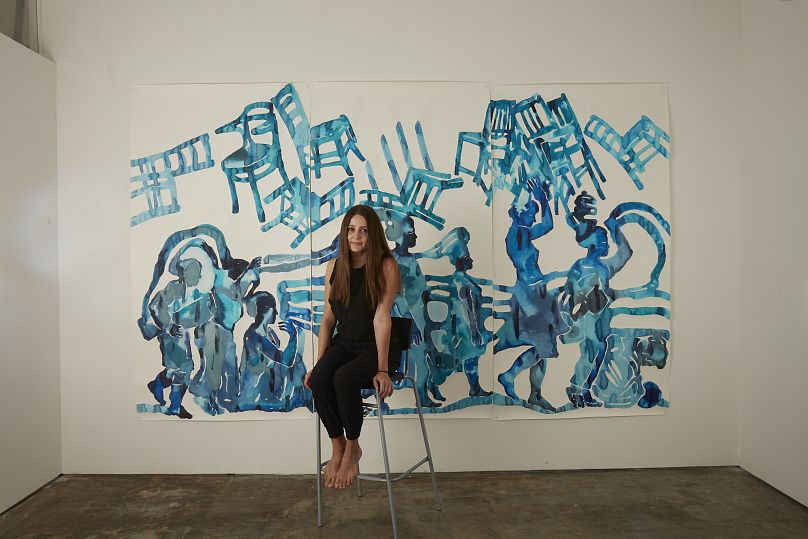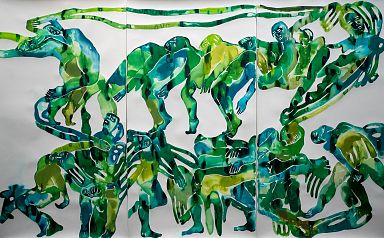Muromtseva's show, Over the Slopes of Speech, adorns the gallery space with epic watercolour triptychs, each telling the story of immigrant women – an apt endeavour in a country where immigrants make up close to 90% of the population.
Amid Dubai's industrial district Al Quoz district lies something unexpected: a hub of creativity, drawing artists, designers and art lovers from around the world to an unassuming part of a city famed for its glitz.
In the 15 years since the art crowd started making its mark on the area, Alserkal Avenue has been the heart of this movement; of late, however, a group of innovative spaces has been moving the centre of gravity slightly south.
Among these is the young NIKA Project Space, set on Al Khayat Avenue, which – despite having only just celebrated its first anniversary – is already making waves on the Dubai art scene.
Founded by Russian-born lawyer-turned-gallerist Veronika Berezina, NIKA champions and practically supports the work of female artists and curators, with a particular focus on practitioners from the Global South – not least via its research and residency programme.
Among those to have taken part is New York-based artist Katya Muromtseva, herself an immigrant and anti-war activist who found herself forced to leave her native Russia.
Her show Over the Slopes of Speech adorns the space with epic watercolour triptychs, each telling the story of immigrant women (and in some cases accompanied by a pamphlet containing the full written interview) – an apt endeavour in a country where immigrants make up close to 90% of the population.
The monumental paintings are based on interviews the artist conducted both in Dubai and her adopted home New York, exploring the experience and resilience of women from countries including Ukraine, Turkmenistan, Russia, Ghana and Nigeria, and prompting reflection on wider themes of belonging, memory, borders and control.
Euronews Culture sat down with Muromtseva to speak about her own experience of immigration, her work committing the stories of other immigrant women to paper, the dynamic UAE arts scene, and her participation in the upcoming Venice Biennale.
Your works come from discussions you had with immigrant women. Did they say anything that surprised you?
Dr. Maya's [a doctor who fled Turkmenistan and eventually started her own cosmetology business in Dubai] story really shocked me. I've never met a person from Turkmenistan in my life, it’s a very closed country. Her whole story was very harsh, but also how she managed it was shocking for me, because she does not complain. She just works and works and works, and looks to the future, like an acrobat on a high wire who cannot look back, because to do so would mean falling off.
Could you tell me a bit about the title of the exhibition, which I believe is taken from a poem?
Yes, it's taken from a poem by Mahmoud Darwish. He was a Palestinian poet, who actually came to the Soviet Union and is very widely translated in Russian. This particular poem – No More And No Less – is about being a woman, and one of the lines in the poem – “over the slopes of speech” – struck me as perfect. This show really is “over the slopes of speech”, because it's all made from all the words I listened to.
What is it about watercolours that allows you to engage with or represent the topics you deal with in the show?
This is my favourite medium, though I also work with shadow theatre, video and installation. On the one hand I like that I need to have control over the paint because, if it leaks, the whole piece is spoiled. On the other, it's sometimes very unpredictable, because it takes two days to dry. It's like life – some parts you can control and some parts are just uncontrollable. I asked my interviewees: “When did you start feeling that you are living in history?” This question is actually about how you face the circumstances that you cannot control.
How has your own experience of becoming an immigrant shaped your work on this show, and more broadly?
I think it shaped my understanding of these women. If I wasn’t an immigrant myself, I would never have come up with this idea and I would never have understood them as deeply. Also they kind of helped me too – to adjust to a new culture and be an immigrant myself. When you talk with somebody and they share their experience, you feel you’re not alone.
How did the NIKA Project Space Research and Residency programme help you to develop your practice, and expand your thinking on the themes you deal with in this show?
This is my first time in the Middle East. I think it's very important to actually visit the Middle East at least once in life. You hear so much about it from very different perspectives, and so many stereotypes about it. But when you get here, you feel it’s very much its own thing, and you cannot judge it from the outside. Being here has broadened my understanding of life and my horizons.
Practically speaking, the studio they rented for me for the residency – a huge warehouse – has been amazing. I've never had such a big studio in my life. NIKA Project Space has also connected me to so many people, and supported me materially, in terms of paint and everything I needed to produce the work.
What do you think is particularly exciting about the creative scene here in the UAE?
I like that at NIKA they are very thoughtful with their programme, and it’s not always “business first”: the idea is to do something impactful, and to create some sort of community and connection. They also want to really work with artists from the global south and local artists and curators too – the last show here, I Can No Longer Produce the Limits of My Own Body, was with Dubai-based curator Nadine Khalil.
I’m also very excited about Sharjah (a neighbouring city). The Sharjah Triennial is so interesting, and particularly how they use non-conventional spaces to show the works: a hospital, slaughterhouse, school. This is something I do in my work – I’ve painted murals in nursing homes, and set up a balcony gallery during the pandemic. It's not as alienating as it can be when it’s just in the “white cube”. It's really welcoming because it's part of your everyday experience.
More generally, because the art scene here is relatively young, I think it’s generally more open and accepting than, say, New York and London.
You’re participating in the Croatia Pavilion at the Venice Biennale this year. How does it feel as a Russian artist to have an active role at Venice? (The 2024 Venice Biennale will once again not include a Russian pavilion)
I was invited by Vlatka Horvat, who is representing Croatia. She asked immigrant artists to create a piece for her that reflects the immigrant experience of their diaspora and their community where they live, which is then taken by someone in the art world (not by any delivery service!) to Venice – it’s called By the Means at Hand.
I'm very against the war in Ukraine, in fact I did a protest exhibition called Women in Black Against the War. I think it's important to express your political position, and to show that there are a lot of people in Russia who are against the war.
As Yulia Navalnya said in her speech in front of the European Parliament recently, it’s important to support everybody who is against Putin and the war – that's how you might actually change something.
Over the Slopes of Speech runs at NIKA Project Space until 4 May 2024.













